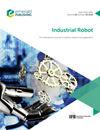Kinematic modeling of a spatial three degrees-of-freedom compliant micro-motion parallel mechanism considering input coupling effect and bilateral restrained torsion
IF 1.9
4区 计算机科学
Q3 ENGINEERING, INDUSTRIAL
Industrial Robot-The International Journal of Robotics Research and Application
Pub Date : 2022-11-09
DOI:10.1108/ir-06-2022-0146
引用次数: 1
Abstract
Purpose This paper aims to improve the kinematic modeling accuracy of a spatial three-degrees-of-freedom compliant micro-motion parallel mechanism by proposing a modified modeling method based on the structural matrix method (SMM). Design/methodology/approach This paper analyzes the problem that the torsional compliance equation of the circular notched hinge is no longer applicable because it is subject to bilateral restrained torsion. The torsional compliance equation is modified by introducing the relative length coefficient. The input coupling effect, which is often neglected, is considered in kinematic modeling. The symbolic expression of the input coupling matrix is obtained. Theory, simulation and experimentation are presented to show the validity of the proposed kinematic model. Findings The results show that the proposed kinematics model can improve the modeling accuracy by comparing the theoretical, finite element method (FEM) and experimental method. Originality/value This work provides a feasible scheme for CMPM kinematics modeling. It can be better applied to the optimization design based on the kinematic model in the future.考虑输入耦合效应和双边约束扭转的空间三自由度柔顺微动并联机构运动学建模
为了提高空间三自由度柔顺微动并联机构的运动学建模精度,提出了一种基于结构矩阵法(SMM)的改进建模方法。设计方法分析了圆形缺口铰受双边约束扭转影响而不再适用扭转柔度方程的问题。引入相对长度系数对扭转柔度方程进行了修正。在运动学建模中考虑了常被忽略的输入耦合效应。得到了输入耦合矩阵的符号表达式。理论、仿真和实验证明了所提出的运动学模型的有效性。通过理论、有限元法和实验方法的比较,结果表明所提出的运动学模型可以提高建模精度。本文为CMPM运动学建模提供了一种可行的方案。今后可以更好地应用于基于运动学模型的优化设计。
本文章由计算机程序翻译,如有差异,请以英文原文为准。
求助全文
约1分钟内获得全文
求助全文
来源期刊
CiteScore
4.50
自引率
16.70%
发文量
86
审稿时长
5.7 months
期刊介绍:
Industrial Robot publishes peer reviewed research articles, technology reviews and specially commissioned case studies. Each issue includes high quality content covering all aspects of robotic technology, and reflecting the most interesting and strategically important research and development activities from around the world.
The journal’s policy of not publishing work that has only been tested in simulation means that only the very best and most practical research articles are included. This ensures that the material that is published has real relevance and value for commercial manufacturing and research organizations. Industrial Robot''s coverage includes, but is not restricted to:
Automatic assembly
Flexible manufacturing
Programming optimisation
Simulation and offline programming
Service robots
Autonomous robots
Swarm intelligence
Humanoid robots
Prosthetics and exoskeletons
Machine intelligence
Military robots
Underwater and aerial robots
Cooperative robots
Flexible grippers and tactile sensing
Robot vision
Teleoperation
Mobile robots
Search and rescue robots
Robot welding
Collision avoidance
Robotic machining
Surgical robots
Call for Papers 2020
AI for Autonomous Unmanned Systems
Agricultural Robot
Brain-Computer Interfaces for Human-Robot Interaction
Cooperative Robots
Robots for Environmental Monitoring
Rehabilitation Robots
Wearable Robotics/Exoskeletons.

 求助内容:
求助内容: 应助结果提醒方式:
应助结果提醒方式:


